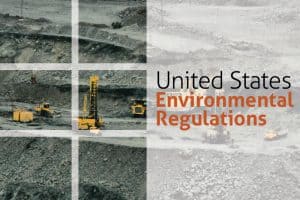 The United States, even after some relaxation of environmental regulations in recent years, has a large legal apparatus governing mining operations and the proper cleanup of antiquated mines. Many states have developed their own mining regulatory statutes, but they are usually as or more stringent than the federal laws.
The United States, even after some relaxation of environmental regulations in recent years, has a large legal apparatus governing mining operations and the proper cleanup of antiquated mines. Many states have developed their own mining regulatory statutes, but they are usually as or more stringent than the federal laws.
The first layer of environmental regulation imposed on mining operations is the mandatory possession of a government-approved permit for all new and ongoing mining operations in the United States, including strictly exploratory missions. The impetus for this first layer is to ensure that all environmental laws are being followed from the beginning of the mining process until the end.
In spite of recent erosions of its power, the National Environmental Policy Act (NEPA) is still the basic framework of all environmental policies for the US. All processes for determining environmental consequences of all federal orders and actions, including the permission of new mine development on federally-owned lands, are defined by NEPA.
The Comprehensive Environmental Response, Compensation, and Liability Act (CERCLA) gives the government authority to respond to any release of hazardous substances, which have a broad definition under CERCLA and have, in the past, included the spillage or release of mining, milling, and smelter waste products. CERCLA is used as a catch-all for any hazardous material released into the environment not enumerated in the Resource Conservation and Recovery Act of 1976, which clearly lists most mining, milling, and smelting solid wastes.
There are separate laws governing the potential damage to different parts of the environment. The Clean Air Act of 1970, The Clean Water Act of 1977, and the Toxic Substances Control Act of 1977 all protect vital environmental resources, and mining operations have to take them into consideration.
The Clean Air Act (CAA) addresses airborne pollution that harms humans or natural resources. The CAA has most recently been known for its automobile emissions regulations and efforts to combat air pollution in cities around the country, but it also covers dust from mining operations, exhaust emissions from heavy mining equipment, tailings disposal, and emissions from facilities like smelters.
Similar to the CAA, the Clean Water Act (CWA) regulates pollution that affects water supplies and waterways. The CWA established the National Pollutant Discharge Elimination System, which allows operations like mines to obtain permits for surface water discharges. Most CWA regulations have to do with the safe disposal of mining waters, but it also administers proper pumping or draining of mine water back to the surface, controlling storm water runoff, and controlling seepage from tailings impoundments.
All of these environmental regulations surrounding mines serve a purpose. Keeping natural resources sustainable is in everyone’s best interest, including the mining companies themselves, which rely on these resources for their production. The Environmental Protection Agency, for the time being, also helps protect the communities surrounding mines and mining operations around the United States, assuring that all generations have access to clean water and air. If the mining operators are good stewards to the land and take some precautions, they will never run afoul of these federal regulations or their state counterparts.








